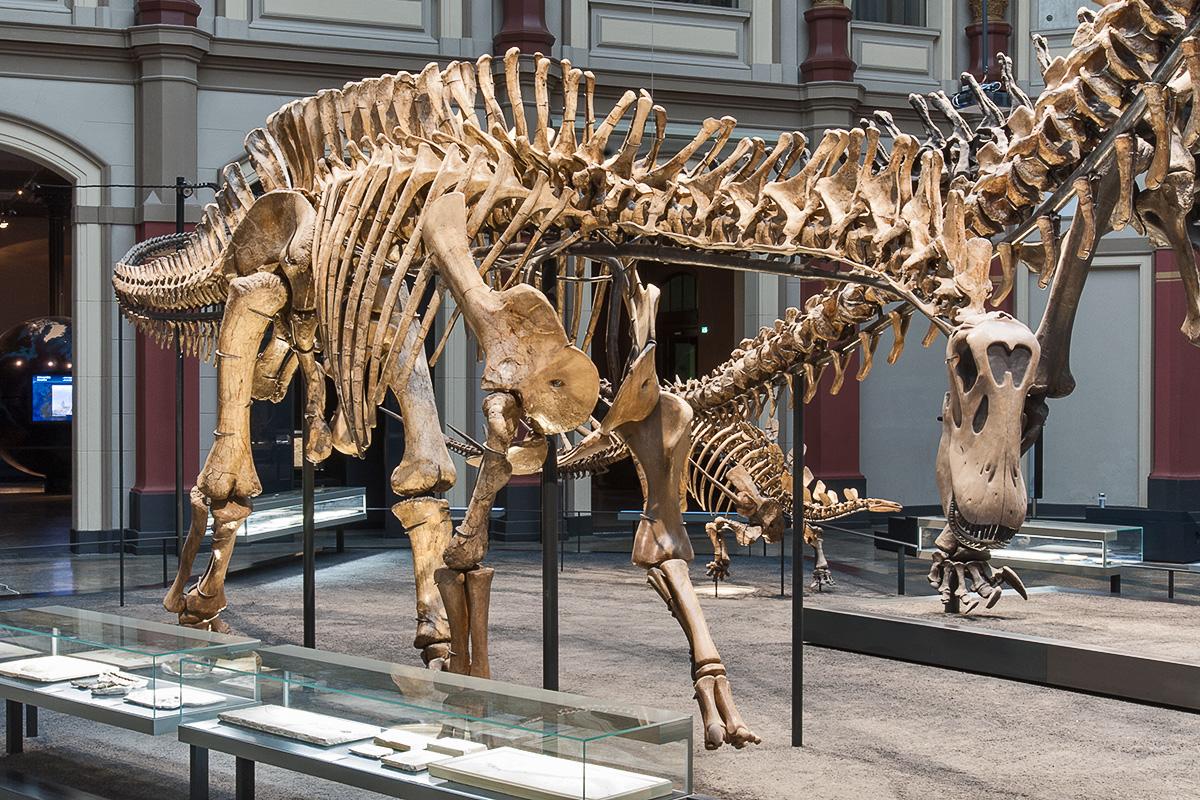Research questions
Their extreme size makes sauropod dinosaurs fascinating research objects. My research covers aspects of the functional morphology, palaeoecology and systematics of sauropods from the Jurassic (200-142 MA). Reconstructing their dietary preferences, locomotor capabilities and mobility of the body, as well as their systematic interrelationships adds to the knowledge of the palaeobiology of the group and thereby enhances new and more detailed views into past ecosystems. The Museum für Naturkunde houses a large collection of dinosaur fossils that allow for a large number of different scientifc research topics. Particularly important is the material of dinosaur fossils from Tendaguru (Upper Jurassic, Tanzania), which includes a large number of well preserved skeletal remains of different sauropod taxa.
Similar to extant birds, sauropods had an air-sac system in their postcranial skeleton, which was responsible for hollowing out the bones of the vertebral column. The air-sac system of sauropods is part of my research. Besides the importance of the air-sac system for the respiration system (effective ventilation of the lung by large air-sacs functioning like bellows), the presence of air sacs leads to a substantial reduction of body weight and thereby is an important factor for enhancement of large to huge body sizes. Computed tomographical images show the extension and architecture of the hollowing out of vertebrae, and play an important role for determination of the systematic position of single sauropod taxa.
Functional contexts in the sauropod body can be studied by recontructing their soft tissues such as muscles, ligaments, and air sacs, and the mobility of certain skeletal units. In my research, I devise biomechanical models from such soft-tissue and mobility reconstruction to find out more about neck mobility and the operation of the long necks during feeding, stabilization of the body during locomotion, and the biomechanics of sauropod tails. An important aspect for the reconstruction of palaeobiologcial aspects in sauropods is also the study of their diets. Sauropod were exclusively herbivores, with regular tooth replacement. With the help of collection material at the Museum für Naturkunde it is possible to reconstruct the frequency of tooth replacement for different sauropods. Computed tomographic images show the replacement teeth within the jaws of these sauropods, which appeared either as single replacement teeth or even in rows. By this research, it can be deduced how different sauropod taxa in the same ecosystem either were generalistic feeders, or specialized towards more tough or more soft vegetation for their diets. Additionally, preservation of braincases allows for the virtual reconstruction of endocasts of the brains and brain nerves of different sauropods.
The systematic relationships of sauropods are well established for large groups, but single genera have often an unsettled taxonomic history. In the specific case of the sauropods from Tendaguru (Upper Jurassic, Tanzania), the descriptions of some genera such as Giraffatitan (“Brachiosaurus”) and Dicraeosaurus are old and need revisions. Other groups, such as the diplodocids previously summarized as “Barosaurus” and Tornieria, and the titanosaurs (Janenschia, Tendaguria) are more diverse than previously assumed. For all of these groups, taxonomic and systematic revisions are necessary to elaborate the true specific and generic diversity of the locality Tendaguru. Apart from the work on the sauropods of Tendaguru, I work also on other sauropod taxa from the Upper Jurassic such as “Cetiosauriscus greppini” (Upper Jurassic, Switzerland).
Methodology
For my research, I use comparative anatomy, working both with fossil material and extant, closely related or functionally similar animals. Regarding their skeleton and soft tissues, and as closest extant relatives to non-avian dinosaurs, birds, for example, are very interesting and helpful for comparison. An important support for my work are nondestructive imaging techniques, in particular medical CT scanning, which shows the internal morphology of the bones. Analytic 3D computing techniques (e.g., FEA, SIMM, CAD modelling, TNT for systematics) can be used for specific research questions or used by cooperation partners.
Partners
- Dr. Veronica Díez-Díaz, Museum für Naturkunde & HU Berlin
- Guido Fritsch, Leibniz Institut für Zoo- und Wildtierforschung
- Dr. Fabien Knoll, University of Manchester
- Dr. Heinrich Mallison, Pöttmes
- Dr. Philip D. Mannion, Imperial College London
- Prof. Dr. Christian A. Meyer, Universität Basel
Selected Publications
- Schwarz, D., Kosch, J., Fritsch, G. & Hildebrandt, T. (2015). Dentition and tooth replacement of Dicraeosaurus hansemanni (Dinosauria, Sauropoda, Diplodocoidea) from the Tendaguru Formation of Tanzania. Journal of Vertebrate Paleontology, 35 (6): e1008134
- Schwarz-Wings, D. & Böhm, N. (2014). A morphometric approach to the specific separation of the humeri and femora of Dicraeosaurus from the Late Jurassic of Tendaguru/Tanzania. - Acta Palaeontologica Polonica, 59 (1): 81-98
- Schilling, R., Barck, M., Weinhold, J., Wings, O., Schwarz-Wings,D., Jastram, B., Issever, A. S. (2014). Virtual reconstruction and 3D print of a dinosaur vertebra. – Radiology, 270 (3): 864-871
- Knoll, F., Witmer, L. M., Ortego, F., Ridgely, R.C. & Schwarz-Wings, D. (2012). The Braincase of the Basal Sauropod Dinosaur Spinophorosaurus and 3D Reconstructions of the Cranial Endocast and Inner Ear. - PLoS ONE, 7 (1): 12 pp.
- Schwarz-Wings, D. (2009). Approach to the reconstruction of the thoracic epaxial musculature of sauropod dinosaurs. – Journal of Vertebrate Paleontology, 29 (2): 517-534
